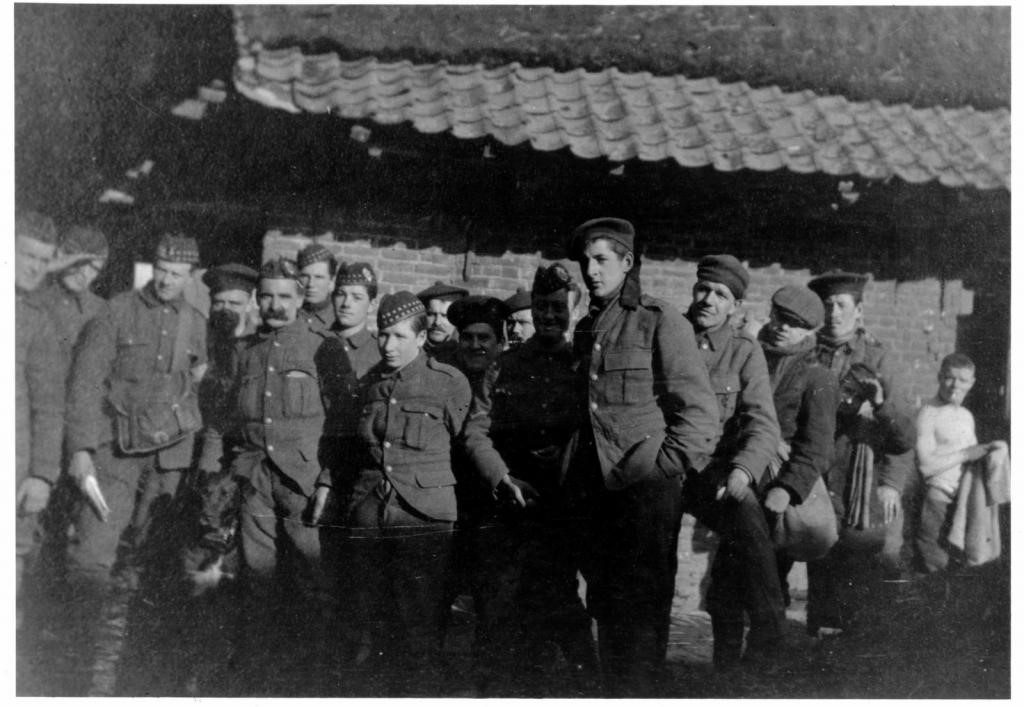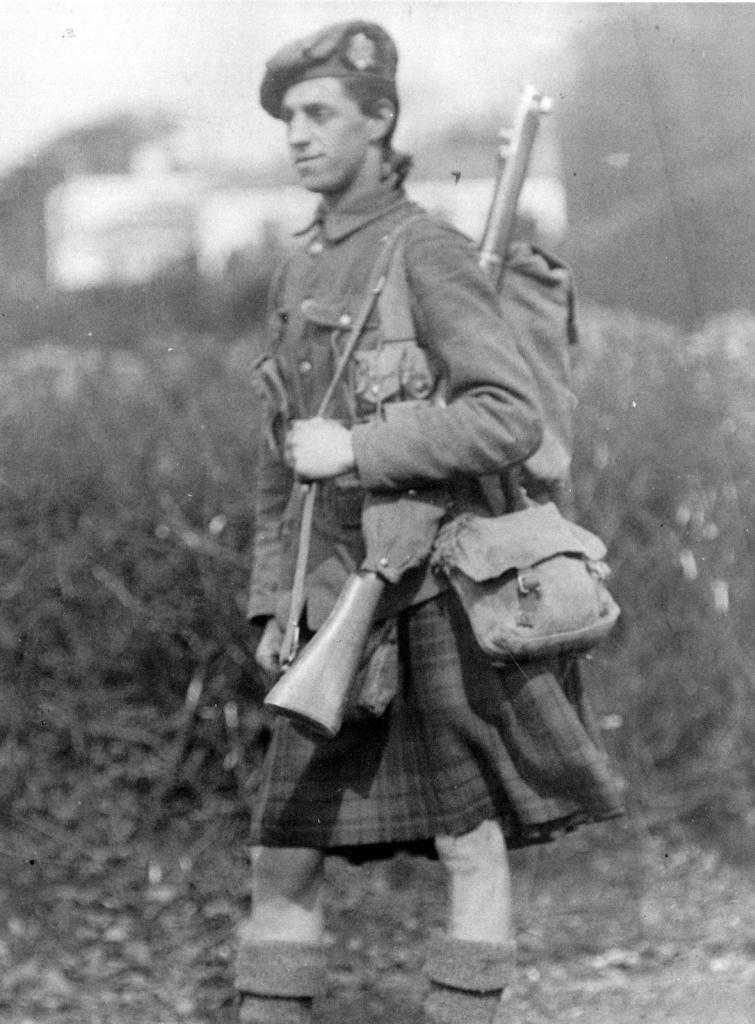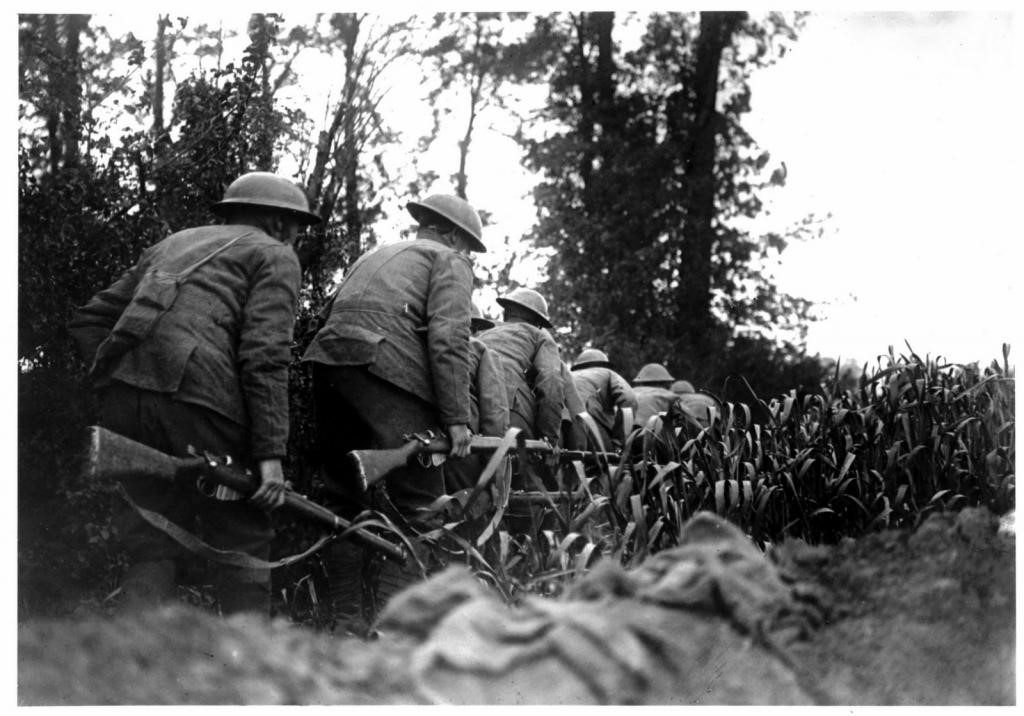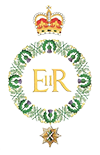THE 1st WORLD WAR BATTALIONS

Soldiers of the 8th Battalion in France 1915
Thirty-five Royal Scots battalions served at various stages during the course of the 1st World War. The Regular Army component, consisting of two active service and one reserve battalions, served throughout the war. The seven Territorial battalions that were in being at the beginning of the war all saw some active service. Furthermore the Territorial units all raised additional battalions for greater or lesser periods of service. Eight New Army battalions were raised during the war. Two of these were raised as reserve battalions but the remaining six all served on the Western Front. Finally three special units were raised, the 19th (Labour) Battalion and the 1st and 2nd Garrison Battalions.
1st Battalion (Regular Army)
In India at the outbreak of war. Arrived in England in November 1914 and moved to France in December. Served on the Western Front until November 1915 when it transferred to Salonika. Served in the Balkans for the remainder of the war. Moved to Russian Georgia for operations against the Bolshevists in December 1918. Returned to Edinburgh in May 1919.
2nd Battalion (Regular Army)
At Plymouth at the outbreak of war. Moved to France in August 1914 and served on the Western Front throughout the war. Returned to Scotland in 1919.
3th (Reserve) Battalion (Regular Army)
At Glencorse at the outbreak of war and moved to Weymouth in August 1914. Returned to Glencorse in May 1915 where it remained until late 1917 when it moved to Mullingar in Ireland. In May 1919 it moved to Maryhill Barracks in Glasgow before the majority of its manpower was subsumed into the 1st and 2nd Battalions. The Battalion was placed in ‘suspended animation’ in August 1923.
1/4th battalion (Queens Edinburgh Rifles) (Territorial Force)
Mobilised in Edinburgh in August 1914. Moved to Gallipoli in June 1915. Transferred to Egypt in January 1916 and served there, and in Palestine, until April 1918. Served on the Western Front from April 1918 until the end of the war. Reduced to cadre strength in March 1919 and returned home in May 1919.
2/4 th Battalion (Queens Edinburgh Rifles) (Territorial Force)
Raised in Edinburgh in September 1914. Served in Penicuik, Peebles, Portobello, Edinburgh and Cambusbarron. Moved to Essex with 65 Division in March 1916 and then to Ireland in January 1917. Disbanded in July 1918.
3/4th Battalion (Queens Edinburgh Rifles) (Territorial Force)
Raised in Peebles in May 1915. It spent the next twelve months in Galashiels, Loanhead and Hawick training drafts for service overseas. In July 1916 it was absorbed into the new 4th (Reserve) Battalion.
4th (Reserve) Battalion (Territorial Force)
Raised at Stobs Camp, Hawick, in July 1916 by absorbing the 3/4th, 3/5th, 3/6th, 3/7th and 3/8th Battalions. Moved to Catterick in September 1916 and absorbed the 3/9th Battalion in July 1917. It returned to Scotland in November 1917 and was quartered in Edinburgh, Haddington and Cupar. In February it was moved to Glasgow where it disbanded later that year.
1/5th Battalion (Queens Edinburgh Rifles) (Territorial Force)
Mobilised in Edinburgh in August 1914 and initially employed on coastal defence duties in Scotland. Joined 29 Division in March 1915. Took part in the Gallipoli campaign from April to December 1915. Moved to Egypt in January 1916 and then to France in March. Amalgamated with the 1/6th Battalion in France in July 1916 and served for the remainder of the war as the 5th/6th Battalion.
2/5th Battalion (Queens Edinburgh Rifles) (Territorial Force)
Raised in Edinburgh in September 1914. Moved to Peebles in May 1915 and thereafter served at Loanhead and then Larbert. Was absorbed into the 2/4th Battalion in November 1916.
3/5th Battalion (Queens Edinburgh Rifles) (Territorial Force)
Raised at Peebles in May 1915 and was stationed in Galashiels, Edinburgh and Hawick. Was absorbed by the 4th (Reserve) Battalion in July 1916.
1/6th Battalion (Territorial Force)
Mobilised in Edinburgh in August 1914 and initially employed on coastal defence duties in Scotland. During 1915 it served at Selkirk, Peebles and Edinburgh before embarking for Alexandria in September. Served with the Western Frontier Force in North Africa from November 1915 to April 1916. Sailed from Alexandria to France in May and amalgamated with the 1/5th Battalion in France in July 1916. Served for the remainder of the war as the 5th/6th Battalion.
2/6th Battalion (Territorial Force)
Raised in Edinburgh in March 1915 and merged with the 2/4th Battalion in November 1915.
3/6th Battalion (Territorial Force)
Raised in Peebles in July 1915 and served at Galashiels and Selkirk before being absorbed by the 4th (Reserve) Battalion in July 1916.
5th/6th Battalion (Territorial Force)
Formed in France in July 1916 from the 1/5th Battalion and the 1/6th Battalion. Served on the Western Front for the remainder of the war. Remained in Belgium until the end of January 1919 when it moved to Germany. In October 1919 it reduced to cadre strength and then returned home to be disbanded.
1/7th Battalion (Territorial Force)
Mobilised in Leith in August 1914. Moved to Gallipoli in June 1915. Transferred to Egypt in January 1916 and served there, and in Palestine, until April 1918. Served on the Western Front from April 1918 until the end of the war. Reduced to cadre strength in March 1919 and returned home on May 1919.
2/7th Battalion (Territorial Force)
Raised in Leith as the 7th (Reserve) Battalion in August 1914 and re-designated as the 2/7th Battalion in January 1915. During 1915 the Battalion served as part of the Scottish Coast Defences Brigade. Later it moved to quarters in Innerleithen and Walkerburn before joining 65 Division in Larbert in November 1915. It moved to Essex in February 1916 from where it despatched drafts for service overseas. In January 1917 the Battalion moved to Dublin, then to tented accommodation in County Galway and it later transferred to the Curragh. The Battalion was disbanded in early 1918.
3/7th Battalion (Territorial Force)
Raised at Peebles in June 1915 to receive those members of the 1/7th Battalion who had been injured in the Gretna disaster on their return from hospital. The battalion moved to Innerleithen in November 1915 and then to Stobs Camp, Hawick in May 1916. Shortly afterwards it was absorbed into the new 4th (Reserve) Battalion.
1/8th Battalion (Territorial Force)
Mobilised at Haddington in August 1914. Moved to France in November 1914, the first Scottish-based Territorial battalion to do so and moved straight to the front, one of only three Territorial units considered good enough to be committed immediately to action. Served throughout the war on the Western Front, initialy in the 7th Division and then, from August 1915, as the pioneer battalion in 51 (Highland) Division. Remained in Belgium until March 1919 when it was reduced to cadre strength and disbanded the following month in Haddington.
2/8th Battalion (Territorial Force)
Raised at Haddinton September 1914. In May 1915 it moved to Peebles and in November, to Falkirk. In February 1916 it joined 65 Division and moved to Essex. In January 1917 it transferred to Ireland where it was disbanded in the summer of 1917.
3/8th Battalion (Territorial Force)
Raised at Peebles in December 1914 where it remained until the summer of 1916, apart from November and December 1915 when it was in billets at Prestonpans. Absorbed by the 4th (Reserve) Battalion in July 1916.

Soldier of the 9th (Highlanders) Battalion
1/9th (Highlanders) Battalion (Territorial Force)
Mobilised in Edinburgh in August 1914. Moved to France in February 1915 and served on the Western Front for the remainder of the war. Remained in Belgium until May 1919 when it reduced to cadre strength and subsequently disbanded.
2/9th (Highlanders) Battalion (Territorial Force)
Raised in September 1914. Stationed at Edinburgh, Kilmarnock, Selkirk and Tillicoultry before moving to Essex in February 1916. Moved to Ireland in the spring of 1917 and was disbanded there in July 1918.
3/9th (Highlanders) Battalion (Territorial Force)
Raised at Peebles in June 1915. Stationed at Selkirk, Stobs Camp, Hawick and Catterick before being absorbed into the 4th (Reserve) Battalion in July 1916.
1/10th (Cyclist) Battalion (Territorial Force)
Mobilised at Linlithgow in August 1914. Served on coastal defence duties in Scotland until April 1918 when it moved to Ireland. Demobilisation began in Ireland in the autumn of 1919 and the Battalion disbanded at Linlithgow in February 1920.
2/10th (Cyclist) Battalion (Territorial Force)
Raised at Linlithgow in September 1914. Served on coastal defence duties until June 1918 when it moved to Dundalk in Ireland. In July it moved to Aldershot and the following month it sailed for Archangel. It served on operations in Northern Russia until June 1919 when it returned to Scotland and disbanded.
11th Battalion (New Army)
Raised in Edinburgh in August 1914. Joined 9 (Scottish) Division and moved to France in May 1915. Spent the remainder of the war on the Western Front. Moved into Germany after the armistice and was reduced to cadre strength at Cologne in November 1919 before being disbanded.
12th Battalion (New Army)
Raised in Edinburgh in August 1914. Joined 9 (Scottish) Division and moved to France in May 1915. Spent the remainder of the war on the Western Front. Moved into Germany after the armistice and was reduced to cadre strength in April 1919 before being disbanded in the UK in June 1919.

12 RS Patrol 1918
13th Battalion (New Army)
Raised in Edinburgh in August 1914. Joined 15 (Scottish) Division and moved to France in July 1915. Spent the remainder of the war on the Western Front. Remained in Belgium after the armistice. Reduced to cadre strength in March 1919 and disbanded in the UK in June 1919.
14th (Reserve) Battalion (New Army)
Raised at Weymouth in November 1914 as a Service Battalion. Became a reserve Battalion in April 1915. Was quartered at Stobs Camp, Hawick, Richmond, South Queensferry and Kirkcaldy. In February 1916, at Kirkcaldy, it became the 54th Training Reserve Battalion.
15th (1st City of Edinburgh) Battalion (New Army) (Cranston’s Battalion)
Raised in Edinburgh in September 1914. During 1915 it was stationed at Troon, Ripon and Sutton Veny. Moved to France in January 1916 and served on the Western Front from February 1916 onwards. Reduced to cadre strength in May 1918 and disbanded in August 1918.
16th (2nd City of Edinburgh) Battalion (New Army) (McCrae’s Battalion)
Rasied in Edinburgh in December 1914. Moved to Ripon in June 1915 then to France in January 1916 and served on the Western Front from February 1916 onwards. Reduced to cadre strength in May 1918 and disbanded in August 1918.
17th Battalion (New Army) (Rosebery’s Bantams)
Raised in Edinburgh in February 1915 as a bantam battalion. During 1915 it was stationed at Glencorse, Selkirk and Masham. Moved to France in December 1916 and served on the Western Front for the remainder of the war. Remained in Belgium after the armistice and was moved to Calais to help quell a mutiny in January 1919. During February and March it was attached to various Labour Groups to prevent looting. Reduced to cadre strength in April 1919 and disbanded in the UK shortly afterwards.
18th (Reserve) Battalion (New Army)
Formed in July 1915. Stationed at Ripon until March 1916 when it moved to Dundee. Shortly afterwards re-titled the 77th Training Battalion and disbanded in October 1917.
19th (Labour) Battalion (Mixed)
Formed at Blairgowrie in April1916 and moved to France the following month. Transferred to the Labour Corps in April 1917.
1st Garrison Battalion (Mixed)
Formed at Edinburgh in August 1915. Moved to Hawick in October 1915 and then to Mudros, and Helles, in the Dardanelles. Moved to Egypt in February 1916 and served in Egypt and Cyprus for the remainder of the war. Returned home and disbanded in May 1919.
2nd Garrsison Battalion (Mixed)
Formed in Leith in August 1916 and a year later it became the 1st Battalion Royal Defence Corps.

